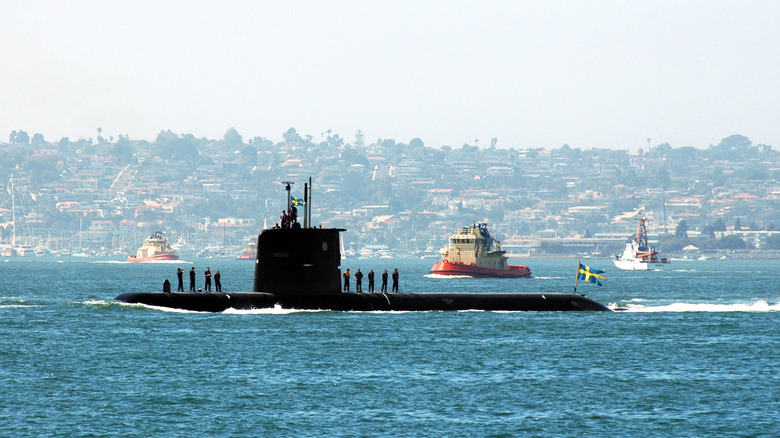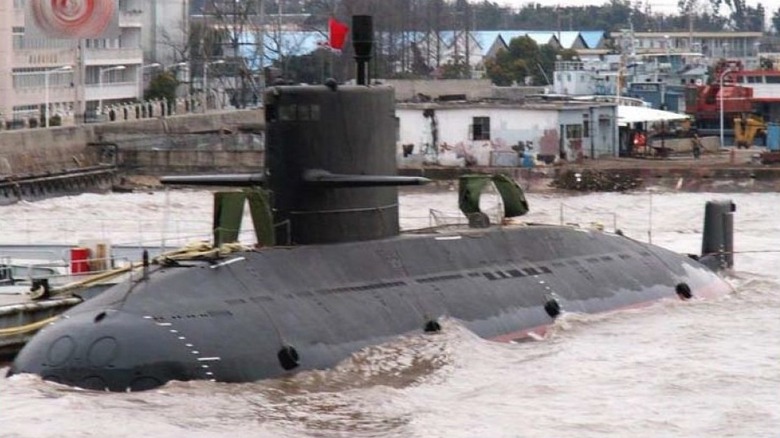How A $100M Submarine 'Sank' A $6B US Nuclear Supercarrier
With the U.S. Navy fielding 11 active carriers, the fleet represents a fearsome deterrent and weapon that can be deployed globally. However, they do make big, lucrative targets. For opposing forces, just adding one of these behemoths to your kill tally could only be described as a prize of unimaginable value that would stretch far beyond the battlefield. And, it has happened — well, sort of. The carrier in question was the USS Ronald Reagan, which, thankfully, is still very much with us. And the fly-in-the-ointment that accounted for the carrier was a $100 million Swedish diesel-powered submarine called the HSMS Gotland.
The Gotland, a 1,600-ton Submarine, fired a barrage of torpedoes that accounted for the plus 100,000-ton carrier in a true David and Goliath moment. The good news for the USS Ronald Reagan (one of the oldest carriers still in service) is that it was only a 2005 war-game, and rather than real torpedoes, the Gotland took a series of photographs of the carrier. Albeit, from a range that was far too close for comfort for the U.S. Navy.
So, just how did a diesel-submarine penetrate the carrier's protection and deliver such a deadly "virtual" blow? Perhaps unsurprisingly, one of the main reasons was stealth. More surprisingly, the stealth of the submarine's diesel power unit was a critical factor. For those of us who associate diesel engines with their signature "clatter sound," this might seem counterintuitive. Let's take a closer look at the war-game outcome that demoralized U.S. anti-submarine specialists.
How a Swedish submarine penetrated a carrier's defenses
It's fair to say that the success of the Gotland in taking out Ronald Reagan sent shockwaves through the U.S. Navy. This wasn't an isolated incident; over two years of war games, the submarine continually managed to evade the layers of anti-submarine defenses protecting a carrier group. Or, in the words of Naval analyst Norman Polmar, the submarine "ran rings" around the U.S. carrier task force. The navy was so impressed — or depressed — it leased the HSMS Gotland for two years to uncover its stealthy secrets.
On the face of it, this is maybe the kind of result to be expected or tolerated if the attacks had been by a high-tech nuclear-powered attack submarine with a price tag that can creep close to $6 billion, not a $100 million diesel-powered submarine. However, Gotland-class submarines have a clever trick to play; namely, the Stirling engines that produce the power, a technology that has been around since the early 1800s.
The Stirling engine in Gotland-class submarines is classified as an "Air Independent Power (AIP)" system, meaning it can stay submerged for weeks rather than days. The Stirling engine works by heating and cooling the gas in a cylinder. For cooling, the submarine uses seawater, a resource it has in abundance, and diesel is merely a heat source. This also makes it incredibly quiet. Indeed, the coolant pumps necessary on nuclear submarines are noisier. Of course, the use of radar-absorbent materials and other stealth technologies is also relevant.
The rising menace of diesel-electric submarines
The decommissioning of the USS Dolphin on January 15, 2007, represented the end of the diesel-submarine era for the U.S. Navy. Since then, the submarine fleet has relied entirely on nuclear-powered boats. At the time, this was a decision that seemed logical, after all, what chance would a boat powered by two diesel bus-engines have against increasingly sophisticated anti-submarine warfare measures? However, as Sweden's Gotland-class submarines proved, the diesel-powered submarine was far from being dead in the water; it just needed re-imagined.
Other countries also see a future in AIP diesel-electric submarines. China, for instance, is believed to have 48 diesel-electric submarines, with 21 being AIP-enabled. Other countries that have or are developing AIP submarines are Japan, Russia, Germany, and India. While nuclear submarines are undoubtedly more advanced than their diesel counterparts, the new generation of AIP boats is more cost-effective to build and operate.
The U.S. Navy hasn't committed to a return to non-nuclear submarines. However, the U.S. Naval Institute believes there is a strong case that these highly capable boats might be what the U.S. Navy needs. While there are certain operational advantages that AIP submarines bring to the table, the price tag is also a big carrot. Even a large "transoceanic" AIP submarine would cost $1.1 billion — or a quarter of a currently manufactured Virginia-class submarine. For comparison, the Gotland entered service in 1995 and cost about $100 million, or $213 million in today's money. Not bad for a boat that sank a U.S. carrier.


